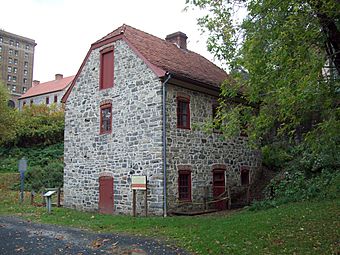Bethlehem Waterworks facts for kids
|
Bethlehem Waterworks
|
|
|
U.S. National Historic Landmark District
Contributing Property |
|

Bethlehem Waterworks, October 2011
|
|
| Location | Bethlehem, Pennsylvania |
|---|---|
| Area | 6.2 acres (2.5 ha) |
| Built | 1753 |
| Part of | Historic Moravian Bethlehem Historic District (ID12001016) |
| NRHP reference No. | 72001142 |
Quick facts for kids Significant dates |
|
| Designated NHL | May 29, 1981 |
| Designated NHLDCP | October 6, 2012 |
The Bethlehem Waterworks, also called the Old Waterworks, is a very old and important water system in Bethlehem, Pennsylvania. It is thought to be the first public water supply in what is now the United States that used pumps to move water.
You can find the pumphouse in the Colonial Industrial Quarter in downtown Bethlehem. It sits between the Monocacy Creek and Main Street. This special building has been recognized as an American Civil Engineering Landmark and an American and Canadian Water Landmark. It was also named a National Historic Landmark in 1981. The Waterworks is part of the Historic Moravian Bethlehem Historic District, which is also a National Historic Landmark District.
Contents
Building the Waterworks
The first water system in Bethlehem was designed in 1755. It was built by a skilled worker named Hans Christoph Christensen from Denmark. His goal was to bring water from a spring at the bottom of a hill up to the homes at the top. This spring provided a lot of water, enough for drinking, cooking, bathing, and even fighting fires.
The First Wooden Waterworks
Hans first built a wooden building for the waterworks. Inside, there was a pump made from a very hard wood called lignum vitae. This pump pushed water through pipes made of hollowed-out hemlock logs. These wooden pipes carried the water up the hill to a wooden tank. From there, the water flowed to different parts of the settlement.
However, this first system had problems. The wooden pipes often leaked or burst. Even when they tried using lead pipes, there were still issues. As the town grew, people needed more water. This meant a bigger and better system was needed.
The Limestone Waterworks of 1762
To meet the growing demand, Hans built a new waterworks in 1762. This time, he used strong limestone for the building. He was paid thirty shillings for his hard work.
The limestone Waterworks building is located near the Monocacy Creek. It's a two-and-a-half-story building, about 24 feet (7.3 meters) square. It has a red tile roof. The building is set over a pit that originally collected water from a nearby spring. Inside, you can see a copy of the original waterwheel. This copy was made using Hans's old drawings.
How the Waterworks Worked
In the past, water power was very important. It replaced the need for people or horses to do heavy work. The waterwheel at the Waterworks was turned by the flowing water from the Monocacy Creek. This power helped move water up to the town.
One waterwheel could create as much power as 100 men! This power turned three cast-iron pumps. These pumps pushed water through pipes, first wooden and later lead, up a hill. The water went into a tall collecting tower, which was nearly 94 feet (28.7 meters) uphill. Today, the Central Moravian Church stands where this tower once was. From the tower, gravity helped the water flow into five different tanks. These tanks supplied water to various buildings in the town.
Challenges and Changes
As Bethlehem continued to grow, the water system faced new problems. The Monocacy Creek couldn't provide enough power for both the Waterworks and a nearby Oil Mill. By the early 1800s, the Oil Mill had to stop working for two days each week so the Waterworks could fill the town's water tanks.
In 1832, the Waterworks moved to the Oil Mill building. This new location helped meet the town's increasing water needs for 81 years. However, a big problem arose: the quality of the spring water became poor. People started getting sick from the water. Because of this, the waterworks had to shut down completely in January 1913.
A Landmark in History
The Bethlehem Waterworks is special because it's believed to be the first pump-powered public water supply in the United States. Other towns, like Boston, had water systems earlier, but they only used gravity to move water. The Bethlehem system was a big step forward in engineering for its time.
Restoration and Preservation
Over the years, the Waterworks site has been studied by archaeologists. In 1972, the building, waterwheel, and pumps were restored. They used the original drawings from the 1700s to make sure everything was accurate.
In 2004, a storm called Hurricane Ivan damaged the waterwheel. But thanks to a special grant, it was repaired in 2009, again using those same old drawings. You can even see parts of the original wooden pipes at the Moravian Museum of Bethlehem.
Today, the 1762 Waterworks is owned by the city of Bethlehem. It is managed by Historic Bethlehem Inc., which is part of Historic Bethlehem Museums & Sites. You can learn about its history on guided tours, but the building itself is currently closed to visitors.



